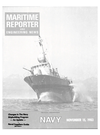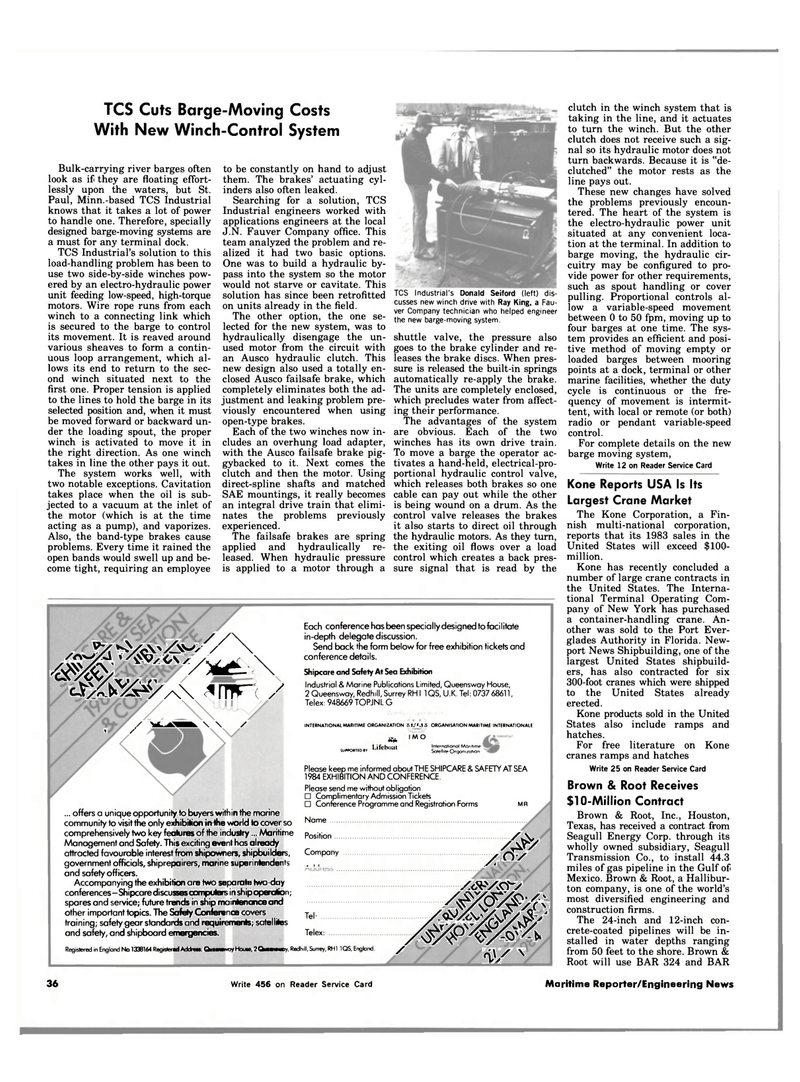
Page 36: of Maritime Reporter Magazine (November 15, 1983)
Read this page in Pdf, Flash or Html5 edition of November 15, 1983 Maritime Reporter Magazine
TCS Cuts Barge-Moving Costs
With New Winch-Control System
Bulk-carrying river barges often look as if they are floating effort- lessly upon the waters, but St.
Paul, Minn.-based TCS Industrial knows that it takes a lot of power to handle one. Therefore, specially designed barge-moving systems are a must for any terminal dock.
TCS Industrial's solution to this load-handling problem has been to use two side-by-side winches pow- ered by an electro-hydraulic power unit feeding low-speed, high-torque motors. Wire rope runs from each winch to a connecting link which is secured to the barge to control its movement. It is reaved around various sheaves to form a contin- uous loop arrangement, which al- lows its end to return to the sec- ond winch situated next to the first one. Proper tension is applied to the lines to hold the barge in its selected position and, when it must be moved forward or backward un- der the loading spout, the proper winch is activated to move it in the right direction. As one winch takes in line the other pays it out.
The system works well, with two notable exceptions. Cavitation takes place when the oil is sub- jected to a vacuum at the inlet of the motor (which is at the time acting as a pump), and vaporizes.
Also, the band-type brakes cause problems. Every time it rained the open bands would swell up and be- come tight, requiring an employee to be constantly on hand to adjust them. The brakes' actuating cyl- inders also often leaked.
Searching for a solution, TCS
Industrial engineers worked with applications engineers at the local
J.N. Fauver Company office. This team analyzed the problem and re- alized it had two basic options.
One was to build a hydraulic by- pass into the system so the motor would not starve or cavitate. This solution has since been retrofitted on units already in the field.
The other option, the one se- lected for the new system, was to hydraulically disengage the un- used motor from the circuit with an Ausco hydraulic clutch. This new design also used a totally en- closed Ausco failsafe brake, which completely eliminates both the ad- justment and leaking problem pre- viously encountered when using open-type brakes.
Each of the two winches now in- cludes an overhung load adapter, with the Ausco failsafe brake pig- gybacked to it. Next comes the clutch and then the motor. Using direct-spline shafts and matched
SAE mountings, it really becomes an integral drive train that elimi- nates the problems previously experienced.
The failsafe brakes are spring applied and hydraulically re- leased. When hydraulic pressure is applied to a motor through a
TCS Industrial's Donald Seiford (left) dis- cusses new winch drive with Ray King, a Fau- ver Company technician who helped engineer the new barge-moving system. shuttle valve, the pressure also goes to the brake cylinder and re- leases the brake discs. When pres- sure is released the built-in springs automatically re-apply the brake.
The units are completely enclosed, which precludes water from affect- ing their performance.
The advantages of the system are obvious. Each of the two winches has its own drive train.
To move a barge the operator ac- tivates a hand-held, electrical-pro- portional hydraulic control valve, which releases both brakes so one cable can pay out while the other is being wound on a drum. As the control valve releases the brakes it also starts to direct oil through the hydraulic motors. As they turn, the exiting oil flows over a load control which creates a back pres- sure signal that is read by the clutch in the winch system that is taking in the line, and it actuates to turn the winch. But the other clutch does not receive such a sig- nal so its hydraulic motor does not turn backwards. Because it is "de- clutched" the motor rests as the line pays out.
These new changes have solved the problems previously encoun- tered. The heart of the system is the electro-hydraulic power unit situated at any convenient loca- tion at the terminal. In addition to barge moving, the hydraulic cir- cuitry may be configured to pro- vide power for other requirements, such as spout handling or cover pulling. Proportional controls al- low a variable-speed movement between 0 to 50 fpm, moving up to four barges at one time. The sys- tem provides an efficient and posi- tive method of moving empty or loaded barges between mooring points at a dock, terminal or other marine facilities, whether the duty cycle is continuous or the fre- quency of movement is intermit- tent, with local or remote (or both) radio or pendant variable-speed control.
For complete details on the new barge moving system,
Write 12 on Reader Service Card
Kone Reports USA Is Its
Largest Crane Market
The Kone Corporation, a Fin- nish multi-national corporation, reports that its 1983 sales in the
United States will exceed $100- million.
Kone has recently concluded a number of large crane contracts in the United States. The Interna- tional Terminal Operating Com- pany of New York has purchased a container-handling crane. An- other was sold to the Port Ever- glades Authority in Florida. New- port News Shipbuilding, one of the largest United States shipbuild- ers, has also contracted for six 300-foot cranes which were shipped to the United States already erected.
Kone products sold in the United
States also include ramps and hatches.
For free literature on Kone cranes ramps and hatches
Write 25 on Reader Service Card
Brown & Root Receives $10-Million Contract
Brown & Root, Inc., Houston,
Texas, has received a contract from
Seagull Energy Corp. through its wholly owned subsidiary, Seagull
Transmission Co., to install 44.3 miles of gas pipeline in the Gulf of
Mexico. Brown & Root, a Hallibur- ton company, is one of the world's most diversified engineering and construction firms.
The 24-inch and 12-inch con- crete-coated pipelines will be in- stalled in water depths ranging from 50 feet to the shore. Brown &
Root will use BAR 324 and BAR
Each conferencehasbeenspeciallydesignedtofacilitate / in-depth delegate discussion.
VyW^/WOv^Mr / Send back the form below for free exhibition tickets and /Ov-^/CA lV^Sy/4s\ / / / conference details. ^^/ Shipcare and Safety At Sea Exhibition
VA /kV/ vC / \ - y Industrial & Marine Publications Limited, Queensway House,
C-Y/X IVZ^r*/ /\\ ^ IP' / 2 Queensway, Redhill, Surrey RHl 1QS, U.K. Tel: 0737 68611, ' Telex: 948669 TOPJNLG 1/ ^ / INTERNATIONAL MARITIME ORGANIZATION ORGANISATION MARITIME INTERNATIONALE ^ I M O
I ifrhu It International Maritime
SUPPORTED BT SolelUe Organ,rot,on
Please keep me informed about THE SHIPCARE & SAFETY AT SEA 1984 EXHIBITION AND CONFERENCE.
Please send me without obligation • Complimentary Admission Tickets • Conference Programme and Registration Forms MR ... offers a unique opportunity to buyers within the marine community to visit the only exhibition in the world to cover so Name ... comprehensively two key features of the industry... Maritime pos;tion JfT\»
Management and Safety. This exciting event has already /J^/ attracted favourable interest from shipowners, shipbuilders, Company Y^vX government officials, shiprepairers, marine superintendents , / and safety officers.
Accompanying the exhibition are two separate two-day conferences-Shipcare discusses computers in ship operation; / v spares and service; future trends in ship maintenance and ^/^/^yfv other important topics. The Safety Conference covers Te|. !/*Sr' training; safety gear standards and requirements; satellites /ArVWT/Ujy^V^ and safety, and shipboard emergencies. Telex: ^/^^L^/qv/^
Registered in England No 1338164 Registered Address: QueerwwyHou«e,2Queensv«iy, Redhill, Surrey, RtHl 1QS, England. / C^S N 36 Write 456 on Reader Service Card Maritime Reporter/Engineering News

 35
35

 37
37
